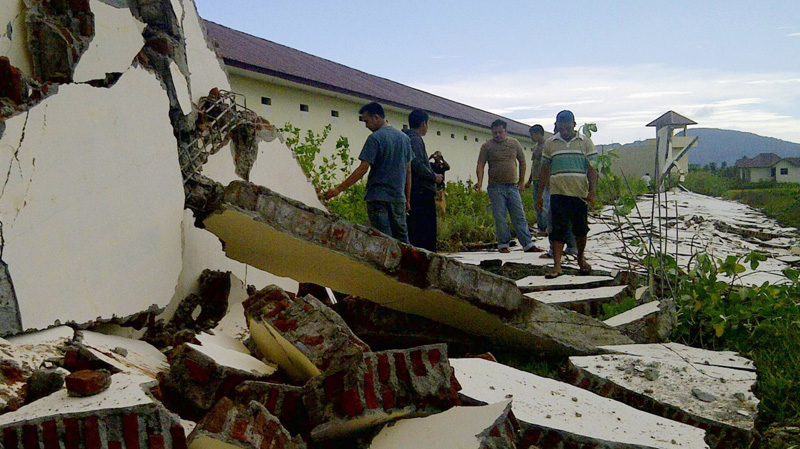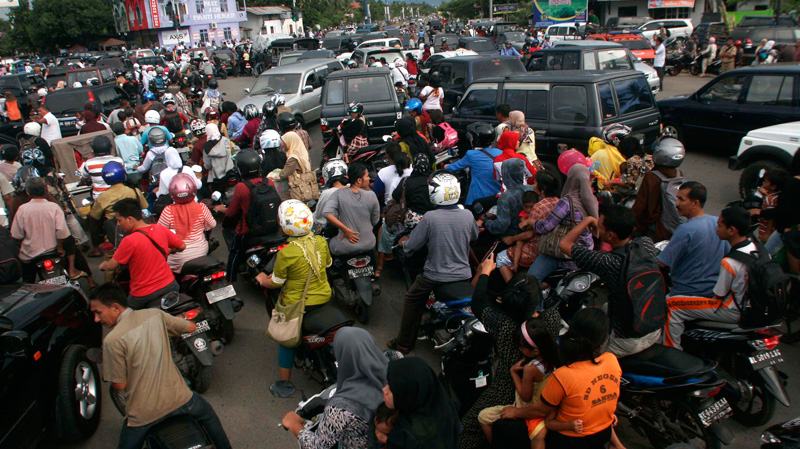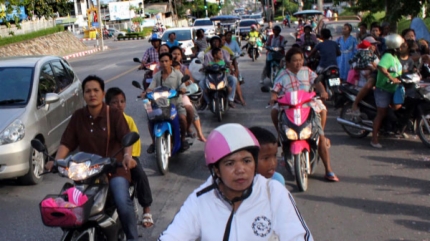Indian Ocean quakes cause panic, little damage
Residents flee on motorcycles to high ground after receiving warning signals after an earthquake off Indonesia's western coast shook hit Phuket, Wednesday, April 11, 2012. (AP)

People look at walls damaged by a strong earthquake at a prison in Aceh province in Indonesia, Wednesday, April 11, 2012. (AP / Kyodo News) 
People are stuck in a traffic jam as they evacuate to higher ground after a strong earthquake was felt in Banda Aceh, Aceh province, Sumatra island, Indonesia, Wednesday, April 11, 2012. (AP / Heri Juanda) Wind and waves pick up along coast of Bali, Indonesian, after an earthquake prompted Tsunami watch on Wednesday, April 11, 2012. (Lisa LaFlamme / CTV News) In this image made from Indonesian television TV One, people on motorcycles and cars flee after a strong earthquake hit in Aceh in Indonesia, Wednesday, April 11, 2012. (AP / TV One via AP Video) |
Updated: Wed Apr. 11 2012 10:56:23 AM
CTVNews.ca Staff
Before officials announced the threat had passed without major incident, two powerful earthquakes and their subsequent tsunami alerts sparked a few hours of panic and concern in countries across the Indian Ocean Wednesday.
After several hours of tense anticipation, the Pacific Tsunami Warning Center in Hawaii said in its final bulletin on the event that all the tsunami watches triggered by two massive earthquakes off the western coast of Indonesia had been cancelled.
The initial tsunami watch was issued after the initial 8.6-magnitude quake struck 33 kilometres beneath the ocean floor, more than 430 kilometres from Indonesia's Aceh province.
At one point, the watch extended to a long list of countries rimming the Indian Ocean including Australia, India, Myanmar, Malaysia, Pakistan, Thailand, the Maldives, Somalia, Oman, Iran, Sri Lanka, Bangladesh, Kenya, South Africa, Singapore and the British island territory of Diego Garcia.
Then, just as initial fears of a tsunami were subsiding little more than two hours later, an 8.2-magnitude aftershock struck 16 kilometres beneath the ocean floor, more than 600 kilometres from the city of Banda Aceh.
The PTWC said it had recorded a "significant" tsunami, but there were no reports of serious damage as it arrived along Indonesia's evacuated coastline.
According to the PTWC's data, the highest wave measured 1.06 metres over normal sea level at Meulaboh, Indonesia, approximately 265 kilometres southeast of Banda Aceh. The next-highest recording, of 36 centimetres, was made in Sabang on the island of Pulau We less than 50 kilometres north of Banda Aceh.
British geological survey seismologist Roger Musson, who has studied the volatile fault lines in the region, told The Associated Press that the earthquake Wednesday was a strike-slip quake in which the earth shifts horizontally.
Unlike thrust quakes where the earth moves vertically and causes a sudden wave-triggering change in the water level above, he said the action of Wednesday's temblor meant the chance of a significant tsunami developing was slim.
Reporting from Bali, Indonesia, CTV National News chief anchor and senior editor Lisa LaFlamme said, even though she is thousands of kilometres from the epicentre, there was an immediate reaction when the initial quake struck.
"The minute it happened, everybody walked out of the room where I was and started talking about it," LaFlamme told CTV's Canada AM by telephone.
"Everybody is talking about it, everybody is remembering where they were in 2004."
On Dec. 26 of that year a 9.1-magnitude quake struck the same region, triggering a tsunami that swept across the Indian Ocean.
By the time it had dissipated some 230,000 people in about a dozen nations were dead, 170,000 of them in Aceh province alone.
Since then, there has been a co-ordinated effort to improve both risk monitoring and the speed of communicating alerts.
"And so far, they say these systems are working," CTV's South Asia bureau chief Janis Mackey Frayer reported from New Delhi.
"Indonesian officials were saying after the initial quake and aftershocks the biggest problem that they've run into is panic," she added.
"There have been moments of chaos with people trying to move to higher ground, spilling into the streets. (But) they're saying it's the sort of vigilance they had hoped for -- that just wasn't in place in 2004."
Indeed, the head of the World Meteorological Organization's disaster risk reduction program said the communications systems worked so well that the initial alert issued by the U.S. National Weather Service was relayed quickly.
"Our records indicate that all the national meteorological services in the countries at risk by this tsunami have received the warnings in under five minutes," Maryam Golnaraghi told AP.
The sprawling Indonesian archipelago sits at the intersection of several of the world's most active fault lines, making the island nation particularly prone to both earthquakes and volcanoes.
